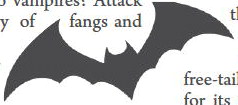The Night Flyers


The sun dropped below the ho- rizon, and I hurried to get a few more things done in the yard before darkness fell. As I walked across the front lawn, my eyes were drawn upward, and I saw the bats. There were three of them — their flight like a chaotic dance through the dimming sky. I stood on the grass and let them flutter erratically just over my head — veering right, darting left — as they chased invisible targets. One dove rapidly, and I heard its wing ap very close to my ear, then it turned and was high in the sky again.
Growing up in the central part of Georgia — Warner Robins and Bonaire – I used to spend long sum mer evenings outside with a crew of neighborhood friends. We played tag and turned cartwheels in the front yard until the streetlights came on signaling us to go inside. As the last rays of light disappeared, bats took to the sky as they hunted for a meal. I remember standing frozen in the yard, head tilted back, eyes wide, as I watched those shadowy -gures darting and swooping overhead. We
nd our minds raced with were kids, and wild ideas about these mysterious creatures. Were they going to swoop down and get us? Get tangled in our hair? Turn into vampires? Attack usinafrenzyof fangsand wings?
Spoiler alert: they never did any of that. But at the time, our imaginations worked overtime, thanks to all the vampire stories we’d heard from friends and vampire movies we saw on television. They are nocturnal creatures, and so we perceived them as “spooky.” We were convinced that they were a menace of the night, just waiting for the perfect moment to strike us and kill us deader than dead.
Fast forward to now, and I've come to appreciate bats for the fas- cinating creatures they truly are. In fact, Georgia — and the South in general — happens to be a home to 16 species of bats, including the little brown bat, the big brown bat, and the tricolored bat. These tiny aerial acrobats are masters of flight, navigating through the night using echolocation (also called bio sonar) to find their meals of insects, especially mosquitoes. Fun fact: One single bat can eat up to 1,000 mosquitoes in an hour. That’s right, these creatures are doing us all a huge favor by keeping those blood-sucking skeeters i n check.
But bats are m o re than just m o s – quito-eating machines. They play an essential role in ecosystems, particularly in the South, where some species help pollinate plants and disperse seeds. The Mexican free-tailed bat, for instance, is known for its migration from Mexico into the southern U.S., including parts o f Georgia. These bats are not just pollinators, but they’re a l s o capable of flying at speeds of up to 99 miles per hour, which some say makes them the fastest flying mammal on the planet — even faster than a cheetah!
But despite all the good they do, bats are often misunderstood and vilified. The myths about bats attacking people or getting tangled in hair? Totally unfounded. They seem to swoop down at our heads, but they aren’t aer us. Insects are a(racted to our body heat, and the bats are after the insects. Bats have gotten very close to me before, but they’ve never made contact with me. Not once. continued from page
And as for turning into vampires? Well, that’s just good ol' folklore at play. In reality, bats are shy, gentle creatures that would much rather keep their distance from humans.
When we first moved to Northwest Georgia, a farmer across the street told me that there’s a cave on a rocky hill not far from here. He told me that he had seen the bats flying out of the cave before. I've also read that they roost in hollowed trees, and sometimes, they invade a home’s attic, but luckily, we’ve never had that problem.
And like other animals, some bat populations are struggling to stay alive due to habitat loss, pesticides, water quality and a disease known as white-nose syndrome. All of these factors combined have led to a steep decline in their numbers, prompting their inclusion on the “species of concern” lists.
So next time you find yourself looking up at the evening sky, don’t be alarmed when you see those familiar winged silhouettes zigzagging through the air. Bats are not out to get you — they’re just doing their nightly rounds, keeping the mosquito population under control and reminding us that the world is filled with wonder, in the day, and in the night.













out of
Posted on